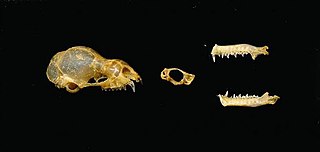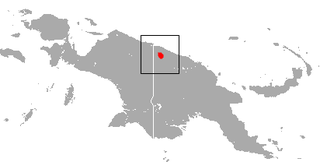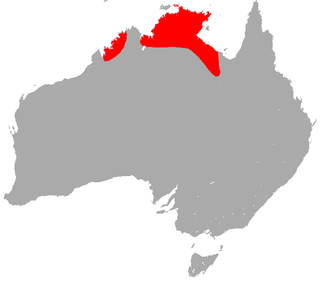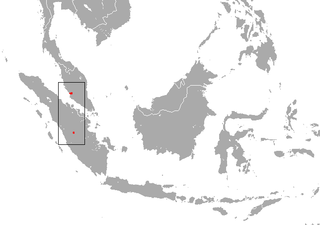
The Indian roundleaf bat, also known as the large Ceylon leaf-nosed bat or Kelaart's leaf‐nosed bat is a species of bat in the family Hipposideridae. It is endemic to the Indian subcontinent, with marginal populations also detected in Southeast Asia. Its natural habitats are subtropical or tropical dry forests and caves. The bat has three subspecies that occur in India, Sri Lanka, and Myanmar. The Indian subspecies, H. l. indus, is smaller than the ones found in Sri Lanka and Myanmar, although there are no other characteristics that differentiate the subspecies.

The fawn leaf-nosed bat is a species of bat in the family Hipposideridae found in Australia, Indonesia, Malaysia, the Philippines and Vanuatu.

The ashy roundleaf bat is a species of bat in the family Hipposideridae found in Bhutan, Cambodia, India, Indonesia, Laos, Malaysia, Myanmar, Nepal, Pakistan, Thailand, and Vietnam.

The Makira roundleaf bat is a species of bat in the family Hipposideridae endemic to the Solomon Islands.

The Khajuria's leaf-nosed bat, also known as Durga Das's leaf-nosed bat, is a species of bat in the family Hipposideridae. It is endemic to India. Its natural habitat is caves. It is threatened by habitat loss.

Hill's roundleaf bat is a species of bat in the family Hipposideridae endemic to Papua New Guinea.

The Kolar leaf-nosed bat, or leafletted leaf-nosed bat is a species of bat in the family Hipposideridae. It is endemic to India. Its natural habitats are subtropical or tropical dry forests and caves. It is found in only one cave in India, and its population is less than 200 individuals.

The crested roundleaf bat is a species of bat in the family Hipposideridae. It is endemic to Indonesia.

The big-eared roundleaf bat is a species of bat in the family Hipposideridae. It is endemic to Indonesia, known from Kangean Islands, southwestern Sulawesi and Seram Island. It roosts in caves and tree hollows and probably forages in woodland. It is threatened by habitat loss through logging and other human activities.

The Maduran leaf-nosed bat is a species of bat in the family Hipposideridae endemic to Indonesia. This species is known from the eastern half of Java and on Madura Island. It is found below 1,000 metres (3,300 ft). It is an IUCN Red List Near Threatened species, with the status changed from Least Concern after a 2021 assessment.

The Biak roundleaf bat or Geelvinck Bay leaf-nosed bat is a species of bat in the family Hipposideridae. It is endemic to the Biak Islands and Cenderawasih Bay area of Papua Province, located in Western New Guinea, Indonesia.

The Pomona roundleaf bat, Pomona leaf-nosed bat, or Andersen's leaf-nosed bat is a species of bat in the family Hipposideridae that is endemic to India.

Semon's leaf-nosed bat or Semon's roundleaf bat is a species of bat in the family Hipposideridae. It is found in Australia and Papua New Guinea.

The northern leaf-nosed bat is a micro-bat of the family Hipposideridae, known as "leaf-nosed" bats. The species is endemic to northern regions of Australia. They are highly manoeuvrable in flight, and use echolocation to forage for insect prey.

The Sumba roundleaf bat is a species of bat in the family Hipposideridae. It lives in Indonesia and East Timor. It is present on the islands of Sumba, Rote, Sumbawa, Flores, Semau, and Savu.

The São Tomé leaf-nosed bat is a species of bat in the family Hipposideridae. It is endemic to the island of São Tomé, in the Gulf of Guinea off the western coast of Africa. The bat's natural habitats are subtropical or tropical moist lowland forests and caves.

The Arnhem leaf-nosed bat is a species of bat in the family Hipposideridae. It lives in the sandstone areas of Kakadu National Park.

The orbiculus leaf-nosed bat, also known as the orbiculus roundleaf bat and small disc roundleaf bat, is a species of bat from the family Hipposideridae. The species has been found on the island of Sumatra in Indonesia and on peninsular Malaysia.

Hipposideros atrox, commonly known as the lesser bicolored leaf-nosed bat, is a species of bat found in Southeast Asia. Originally described as a subspecies in 1918, it was recognized as a full species in 2010. It uses echolocation to navigate and find prey, and roosts in caves during the day.

Pendlebury's roundleaf bat is a species of bat in the family Hipposideridae. It was previously considered a subspecies of H. turpis, but has now been raised to full species level. It is endemic to Thailand and is found in limestone karst areas.





















